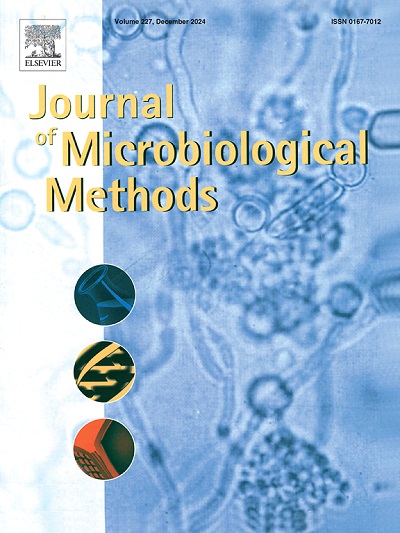基于pcr的假结核棒状杆菌DNA指纹图谱的基因分型研究
IF 1.7
4区 生物学
Q4 BIOCHEMICAL RESEARCH METHODS
引用次数: 0
摘要
表型分型方法往往费时费力,而且不能充分区分相关菌株。创新的分子技术可以通过分析 DNA 直接进行分型,并作为细菌分型、分子流行病学和分子系统化的重要工具得到广泛应用。本研究旨在使用基于 PCR 的 DNA 指纹方法对假结核棒状杆菌菌株进行基因分型,并对这些方法进行比较评估。在研究范围内,对 17 株假结核棒状杆菌进行了分析。使用 ERIC2 引物进行肠杆菌重复基因间共识(ERIC)-PCR;使用 P5、P6、P11、P14、P16、P21 和 M13 引物进行随机扩增多态性(RAPD)DNA-PCR;以及使用(GTG)5 引物进行(GTG)5-PCR。根据每种引物的基因分型结果,计算了各种方法的分辨能力和置信区间。所有菌株都产生了基因分型引物的扩增产物。使用 ERIC2、P14、P11、(GTG)5、P21、P5、M13、P6 和 P16 引物进行基因分型后,计算出的鉴别力(置信区间)分别为 0.8603(0.858-0.862)、0.7132(0.709-0.716)、0.6838(0.668-0.699)、0.6397(0.623-0.656)、0.5809(0.560-0.601)、0.3235(0.293-0.353)、0.1176(0.081-0.153)、0.1176(0.081-0.153)和 0.1176(0.081-0.153)。对结果进行比较评估后发现,ERIC2 和 P14 引物对伪结核菌株的基因分型具有较高的分辨能力和置信区间,而 M13、P6 和 P16 引物对菌株的基因分型能力不足。结论是,使用ERIC2和P14引物进行基因分型可可靠地用于调查假结核杆菌感染和/或爆发的分子流行病学。本文章由计算机程序翻译,如有差异,请以英文原文为准。

Genotyping of Corynebacterium pseudotuberculosis isolates using PCR-based DNA fingerprinting methods
Phenotypic typing methods are often time consuming and do not adequately discriminate among the strains involved. Innovative molecular techniques can perform direct typing by analyzing DNA and are becoming widespread as important tools for bacterial typing, molecular epidemiology and molecular systematization. The aim of this study was to genotype Corynebacterium pseudotuberculosis strains using PCR-based DNA fingerprinting methods and to evaluate the methods comparatively. Within the scope of the study, 17 C. pseudotuberculosis strains were analyzed. The strains were genotyped by enterobacterial repetitive intergenic consensus (ERIC)-PCR using ERIC2 primer; by random amplified polymorphic (RAPD) DNA-PCR using primers P5, P6, P11, P14, P16, P21 and M13; and by (GTG)5-PCR using (GTG)5 primer. The discrimination power and confidence intervals of the methods were calculated based on the genotyping results using each primer. All strains produced amplification products with the primers used for genotyping. As a result of genotyping with ERIC2, P14, P11, (GTG)5, P21, P5, M13, P6 and P16 primers, the discrimination powers (confidence intervals) were calculated as 0.8603(0.858–0.862), 0.7132(0.709–0.716), 0.6838(0.668–0.699), 0.6397(0.623–0.656), 0.5809(0.560–0.601), 0.3235(0.293–0.353), 0.1176(0.081–0.153), 0.1176(0.081–0.153) and 0.1176(0.081–0.153), respectively. As a result of the comparative evaluation of the results, it was observed that ERIC2 and P14 primers had high discrimination power and confidence interval in genotyping C. pseudotuberculosis strains, while M13, P6 and P16 primers were insufficient in genotyping of strains. It was concluded that genotyping with ERIC2 and P14 primers can be used reliably in investigating the molecular epidemiology of infections and/or outbreaks caused by C. pseudotuberculosis.
求助全文
通过发布文献求助,成功后即可免费获取论文全文。
去求助
来源期刊

Journal of microbiological methods
生物-生化研究方法
CiteScore
4.30
自引率
4.50%
发文量
151
审稿时长
29 days
期刊介绍:
The Journal of Microbiological Methods publishes scholarly and original articles, notes and review articles. These articles must include novel and/or state-of-the-art methods, or significant improvements to existing methods. Novel and innovative applications of current methods that are validated and useful will also be published. JMM strives for scholarship, innovation and excellence. This demands scientific rigour, the best available methods and technologies, correctly replicated experiments/tests, the inclusion of proper controls, calibrations, and the correct statistical analysis. The presentation of the data must support the interpretation of the method/approach.
All aspects of microbiology are covered, except virology. These include agricultural microbiology, applied and environmental microbiology, bioassays, bioinformatics, biotechnology, biochemical microbiology, clinical microbiology, diagnostics, food monitoring and quality control microbiology, microbial genetics and genomics, geomicrobiology, microbiome methods regardless of habitat, high through-put sequencing methods and analysis, microbial pathogenesis and host responses, metabolomics, metagenomics, metaproteomics, microbial ecology and diversity, microbial physiology, microbial ultra-structure, microscopic and imaging methods, molecular microbiology, mycology, novel mathematical microbiology and modelling, parasitology, plant-microbe interactions, protein markers/profiles, proteomics, pyrosequencing, public health microbiology, radioisotopes applied to microbiology, robotics applied to microbiological methods,rumen microbiology, microbiological methods for space missions and extreme environments, sampling methods and samplers, soil and sediment microbiology, transcriptomics, veterinary microbiology, sero-diagnostics and typing/identification.
 求助内容:
求助内容: 应助结果提醒方式:
应助结果提醒方式:


